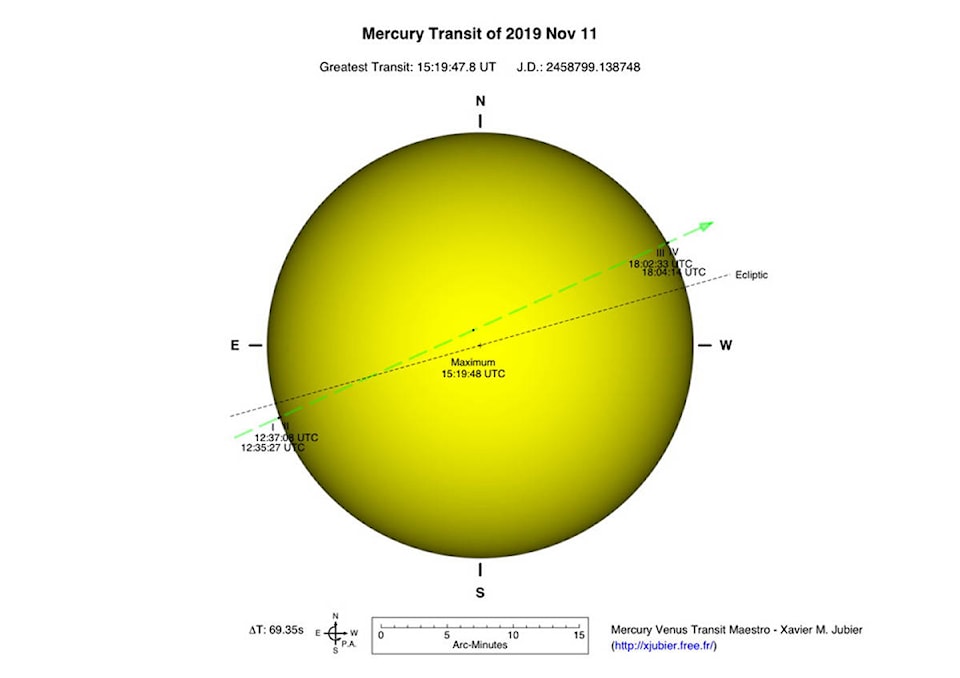By Dan Hicks
Mercury – messenger to the gods in Roman mythology, is our smallest planet, the closest to the sun; and is one of our four inner fellow rocky planets, contrasting with the four outer gas giants. Mercury is oven hot when exposed to the sun, yet so deeply frozen in its shadows that ice exists within its polar craters.
Moonlike in appearance and two fifths Earth’s mass, Mercury is a little larger than our moon and both have suffered the same fate as victims of our early solar system’s heavy debris bombardment; since they are essentially devoid of atmospheres and have been geologically dead for billions of years, their impact craters remain unchanged – evidencing their hard-luck histories.
Both Jupiter moon Ganymede and Saturn moon Titan are larger than Mercury. Our second densest planet, Mercury is almost as dense as Earth and, with a liquid iron core constituting 55% of its volume and a single continental plate – the little planet is shrinking!
At 3.2 light minutes from the sun, Mercury orbits the sun every 88 Earth days and rotates on its axis every 59 Earth days, meaning that it rotates thrice every two Mercury years - giving Mercury our solar system’s longest day - 176 Earth solar days (no need for Daylight Saving Time on Mercury).
At 6.0 light minutes from the sun, Venus, with its searing dense carbon dioxide atmosphere, is our hottest planet; third planet Earth orbits at 8.3 light minutes distance – 1 astronomical unit; and Red Planet Mars – our future second home, waits patiently at 12.6 light minutes out from the sun.
Though Giovanni Zupi’s 1639 telescopic observations of Mercury showed it as having phases like the moon and Venus - explainable only by its orbiting the sun, we owe our intimate knowledge of the planet to two US National Aeronautics & Space Administration (NASA) probes; Mariner 10, active in 1974-75 and Messenger, active from 2004 to 2015.
Messenger orbited Mercury 4,000 times, leaving a wondrous photographic legacy before running out of fuel and crashing onto the planet’s surface; its more primitive predecessor had a kinder fate – consigned to eternity as a solar satellite.
As Mercury never extends any further than 28 degrees from the sun in our sky, it is only visible as a morning or evening star and, in the November 28th dawn, makes its best apparition of the year, ascending to 15 degrees in our eastern sky 45 minutes before sunrise - shinning at a bright minus 0.6 magnitude; the morning star planet will be the most prominent stellar object on the eastern horizon. A telescopic view would show the planet displaying a moonlike orbital phase.
Apparitions aside, Mercury’s outstanding performance will be its November 11th inferior conjunction when it transits across the face of our sun – a significant astronomical event that will not be visible again from the Kootenays for another 33 years - November 9th, 2052.
But our upcoming November 11th transit is the most favorable of the century - the centers of the two heavenly spheres come to within 76 arc seconds of each other. Mercury’s orbit around the sun is inclined 7 degrees to our Earth’s orbit around the sun, hence Mercury’s path across the sky intersects the sun’s path – the ecliptic – at that angle (see diagram).
However, observation of Mercury’s transit is possible only through a specially-equipped telescope, a basic candidate being a refractor with a 13 cm (5 inch) objective lens and an 800 mm focal length and, most importantly - fitted with a front-aperture solar filter.
Attempting to observe the sun through any makeshift contraptions will damage a would-be observer’s eyesight and pointlessly so - Mercury is a mere pinpoint against the solar surface, its apparent diameter being only 1/194th of the apparent solar diameter.
Specifically for Cranbrook, Timeanddate.com lists the times of Mercury’s ingress onto the sun’s disc, midtransit, and egress from the sun, features a transit animation, and for restless transit enthusiasts – includes a countdown clock.
Accordingly, I delivered a formal letter to College of the Rockies President David Walls on November 4th asking that, utilizing college equipment and personnel, he arrange a public viewing of the November 11th Mercury transit for the citizens of Cranbrook, so that they might enjoy the same celestial viewing opportunities as those that have been arranged for Calgarians.
Regrettably, neither my letter nor a November 6th follow-up email elicited a response from the college.
Our local institute of higher learning has no history of engaging the public for special astronomical events and this established institutional indifference is likely well entrenched in its collective psyche. Ironically, the college’s heraldic motto - AD CULMINA – to the summits - suggests that when the November 11th sun arises over the Rockies to the east-southeast, with Mercury’s transit already in progress, it would be greeted by an enthusiastic little crowd of Cranbrookers atop a community forest promontory, awaiting their turn to directly view – through college telescopes – our smallest planet smoothly sliding across the blazing face of our great sun; momentarily contemplating the fragility of our own precious planet while gazing upon a neighboring world of roasting-frigid rock.
But sadly resigning to the status quo, I see the likelihood of such proactive collegial engagement linking the local citizenry to unique astronomical phenomena as being akin to rather unimaginable and macabre doomsday occurrences; eg the Rockies tumbling into the sea, reanimated dinosaurs reclaiming Cranbrook, and Justin apologizing to Jody (arranged from the unlikely to the unthinkable).
Though Cranbrook may fare better in 2052, when once again we will have an opportunity to view a transit of Mercury, we deserve more here and now from our college on the hill.
sources: Royal Astronomical Society of Canada Observer’s Handbook 2019, SkyNews Magazine November-December 2019, Wikipedia.org, & Worldatlas.com.
